
by Lori Vande Krol | Nov 6, 2025 | General Productivity, Goals and Priorities, Habits, Technology, Time Management, Tools
If you’ve seen the film The Social Dilemma on Netflix, you know how deliberately social media is engineered to keep us hooked. (If you haven’t, I recommend watching it!) Every like, notification, and reel is designed to capture and keep your attention—often without you even realizing it.
The good news? You can reclaim your time and attention, but it may take more than willpower alone to break the addictive hold our phones have on us. Here I share seven apps and tools to help you spend less time on your phone, allowing more time for what matters most.
Start with the Built-In Tools You Already Have
1. Digital Wellbeing (Android) / Screen Time (iOS)
What it does: Track and limit your screen time.
How it works: You can find these built-in tools in your settings. Both show exactly how much time you’re spending on every app. You can set daily limits for apps like Facebook or TikTok, and schedule times of day when apps are blocked.
Who it’s great for: Anyone who wants to monitor behavior, set boundaries, and make intentional adjustments without downloading anything extra.
Links: Digital Wellbeing / Screen Time
Add Downloadable Apps for Extra Support
2. Forest
What it does: Stay focused by growing virtual trees.
How it works: Every time you want to focus, you plant a tree. Leave the app to check Instagram or TikTok, and the tree dies. Over time, you’ll grow an entire forest representing your focused hours.
Who it’s great for: Visual learners and anyone motivated by gamification.
Link: Forest
3. Freedom
What it does: Block distracting apps and websites.
How it works: Schedule focus sessions across all your devices to block apps, websites, or even the entire internet if you want deep work time.
Who it’s great for: People who need cross-device control and serious focus sessions.
Link: Freedom
4. One Sec
What it does: Interrupt impulsive app openings.
How it works: Adds a short pause before opening apps —just long enough to ask yourself, “Do I really want to do this?”
Who it’s great for: Increasing intentionality by breaking the habit loop of compulsive checking.
Link: one sec
5. StayFree
What it does: Detailed app usage tracking and blocking across devices.
How it works: Offers insights into your usage patterns and allows you to set daily limits, block full apps, or certain features within apps. You can set reminders for when you’re approaching your limit. It can also give you a gentle pause or notification before you begin scrolling without thinking.
Who it’s great for: Users who want more granular control and analytics across devices.
Link: StayFree
6. Flipd
What it does: Tracks your productivity, boosts your motivation, and connects you with communities.
How it works: “Flip off” distracting apps for a set period, or schedule recurring focus sessions. You can also track your time and celebrate milestones. Connect with communities related to wellness, school, and more.
Who it’s great for: Students, professionals, or anyone who needs extra accountability.
Link: Flipd
7. Unpluq
What it does: Cultivates mindful phone use.
How it works: Uses a tag, or “key,” to unlock apps that you have chosen to block.
Who it’s great for: Those who want that extra control and intention of having to step away from their phone before unlocking apps. Also great to limit kids’ phone time.
Link: Unpluq
Practical Tips for Limiting Social Media
In addition to using supportive tools, here are some daily habits that can help reduce the pull your phone has on you:
- Schedule your scroll time: Instead of opening your phone whenever, block out specific times to check in on texts and messages.
- Set daily app limits: Decide ahead of time how much phone time is reasonable per day. Step away when you hit that limit.
- Batch notifications: Turn off non-essential alerts so you’re not constantly pulled to your phone and potentially back into feeds.
- Phone-free zones: Keep your bedroom, dinner table, or work area free from phones and apps. Out of sight = out of mind.
- Go analog: Use analog alternatives when possible (planners, journals, books, clocks).
Reducing screen time isn’t about restriction—it’s about reclaiming your attention and living intentionally. Start with the tools already on your phone, then layer in apps that support focus, mindfulness, and accountability. With the right combination, you can take back control and make technology work for you.

by Lori Vande Krol | Sep 11, 2025 | General Productivity, Goals and Priorities, Habits, Planning, Time Management, Tools
Do you ever feel like you’re spinning your wheels—busy all day but never quite moving forward? Many of my clients come to me for exactly that reason: they’re craving structure in their personal and work lives that feels supportive but not stifling, and they don’t know where to start. The key is to create a schedule built from habits and routines that support your priorities. It sounds simple, but creating your ideal schedule takes more intention than you might think.
First, Get Clear on Your Priorities
Whenever I begin work with a client, we spend time defining or reviewing their Mission, Vision, and Goals – the first 3 steps in the ProAction Process™. Without this, it is difficult to know which habits and routines will move you towards happiness and success. Once the priorities are clear, and we have a basis for what’s most important, we can then dive into the fun stuff – creating the structured schedule. And, the first action towards determining an ideal, supportive schedule is to define habits and routines.
Define Your Habits
Think of habits as the puzzle pieces towards reaching your goals and creating your vision. Once you are clear on your priorities, these puzzle pieces will fall into place. You can then more easily define which habits you want to cultivate—and how often you want them to show up—then you can stack them into daily routines and weekly rhythms that feel natural. Before you know it, your vision will start to form. Without that clarity, plans and schedules can end up overcomplicated, overwhelming, or unsustainable.
The Habits Frequency Framework
To help my clients get clear on their habits, I use a simple framework. It breaks habits down into four categories based on frequency:
- Daily – the habits you want to anchor your day with (e.g., journaling, exercise, reading)
- Weekly – the habits that keep work and life on track but don’t need daily attention (e.g., team check-ins, sales calls, meal planning, phone call to Mom)
- Monthly – the habits that add intentionality and prevent things from piling up (e.g., filing/scanning, reviewing goals, networking events, date night)
- Annually – the habits that create traditions, resets, and big-picture reflection (e.g., yearly retreat, tax prep, mission and vision refresh, holiday party)
This frequency-based approach makes habits feel less like a mountain to climb and more like the puzzle pieces you can place where they fit best.
I recently worked with a client, Lilly, who was overwhelmed with work and life. She was working nights and weekends just to keep up, barely seeing her family, and she never felt like she could get ahead and look forward. After clarifying Lilly’s priorities, we determined that she was trying to do too many things. She pared back her focus and built habits and routines to support her current, highest priority goals. By defining a habit to review and reset her goals (quarterly and annually), Lilly became more comfortable letting other projects and tasks wait.
Her shorter-term habits (daily, weekly, monthly) were then focused on actions that supported her more immediate goals and priorities…like attending 2 events per month that targeted a specific client-base, blocking time each week to finish her e-book, setting aside time on Sundays to meal plan, scheduling a family outing once per month, and getting to bed earlier every day.
Click below to grab the simple, fillable template I use with clients to map habits by frequency—it’s the perfect first step to designing your own ideal schedule.
Habit Building Template
FREE DOWNLOAD
Build Your Routines and Schedule Them
Once your habit list feels right, it’s time to build routines and schedule them. Daily habits shape your beginning of day and end of day flows. Weekly ones find their home on specific days. Monthly habits might get anchored to a certain date each month. Annual habits can be tied to seasons, months, or meaningful dates.
Once Lilly blocked time for her defined habits and routines, she could more clearly see what her ideal week looked like. She could structure her schedule in a way that allowed her to focus on her current priorities and meet her goal of no-work evenings and weekends. As she developed these habits and worked more intentionally, she felt more accomplished each week – even though she was working less hours.
When your habits are placed with intention and support your mission, vision, and goals, your routines will feel less like rigid rules and more like a supportive rhythm that carries you forward.
Final Thought
Remember: structure doesn’t create habits—habits create structure. Get clear on your priorities, and let your habits build the structure that supports your most productive (and enjoyable) life. So, grab the template and begin mapping out your habits today—your future self will thank you.

by Lori Vande Krol | Mar 14, 2025 | General Productivity, Planning, Time Management, Tools
Time tracking may not be the most exciting task but taking a step back to reflect on how we spend our precious minutes and hours can be a game-changer. When we examine our daily routines, we gain clarity on where our time truly goes, helping us live more intentionally, enhance productivity, reduce procrastination, and reach our goals. Many of my clients have had eye-opening realizations—both big and small—after committing to just a week of time tracking and asking themselves a few simple but revealing questions. Below, I share some practical tips and tools to make time reflection a seamless part of your time management routine.
How to Get Started with Time Reflection
If you’re new to time tracking and reflection, start simple by looking back regularly throughout your day. Chris Bailey, author and Productivity Consultant, suggests the following in his recent blog: “…set a chime on your phone that’ll go off every hour or two. When it goes off, reflect: What did you spend the last hour or two doing? Was it a productive use of your time, attention, and energy?”
A more advanced technique for time tracking allows you to work “as normal” and then reflect and evaluate at the end of each day. Small changes then result in continuous and lasting improvement.
Try these simple steps:
1. Track Your Time: Spend at least a week capturing everything you do throughout the day. Note the activity, time spent, and whether or not the activity was planned or unplanned. Use a journal, spreadsheet, or download the free Time Log below.
2. After reflecting on your day, answer the following questions:
- What did I learn? For example, What tasks took longer than expected? What distracted me from my priorities? What activities provided the most value?
- What can I change?
- What actions will I take?
3. Identify Patterns: Look for trends and areas where you can optimize your schedule, delegate tasks, or eliminate time-wasting activities.
Tools to Make Time Tracking Easier
There are many tools available to help you track and reflect on your time more effectively. A few of these tools include:
- Toggl – A simple yet powerful time tracker for individuals and teams looking for a simple, intuitive interface.
- Clockify – A free tool for tracking time across multiple projects and people.
- RescueTime – Unlike manual trackers, RescueTime runs in the background and provides insights on where your time goes without needing to start or stop timers.
- The simplest…pen and paper! For a template capturing all of the steps mentioned above, click below for a free download.
If you use a paper planner, you might also consider using this to not only plan your time, but track it. One ProAction Planner user shared that she uses the scheduling section of each weekly layout to track her time.
Let me know in the comments below if you use other time-tracking tools or methods that you enjoy.
Making Time Reflection a Habit
To truly benefit from time reflection, make it a regular part of your routine. Set aside 5 minutes at the end of every day and 10-15 minutes at the end of each week to review your time logs and adjust your schedule and routines accordingly. The more consistent you are, the more insights you’ll gain, leading to continuous improvements in productivity and overall well-being.
Final Thoughts
In a recent article by Digital Marketing News, “experienced remote workers,” including myself, were asked to share our favorite time-tracking tip and tool for remote work. Refer to this insightful article for additional ideas and tracking tools. There are many valuable suggestions whether you work remotely or not.
Time is one of our most valuable resources, yet we often let it slip away unnoticed. Taking a step back to analyze how we actually spend our time can reveal inefficiencies, uncover hidden priorities, and highlight areas for improvement. By making time reflection a regular habit, you can gain greater control over your daily schedule and align your actions with your long-term goals. So, take a moment to look back—you might be surprised at how it propels you forward.

by Lori Vande Krol | Nov 20, 2023 | General Productivity, Goals and Priorities, Organization, Planning, Time Management, Tools
There is no question this is a busy time of year. But as we near the end of 2023, there are still a few things you can do to close out the year and prepare for a successful 2024.
1. Spend time on office “maintenance. Schedule a few days to catch up on filing, update your contact database, organize your receipts for the year (send them to Shoeboxed and let them take care of it for you!), empty your email inbox, and/or scan in those piles of paper (I recommend the Fujitsu ScanSnap iX1600 for PC or Mac for this task.) I like to use the last week of the year for these maintenance items. Spending some time to maintain your office productivity systems will help you feel you can start the New Year fresh and accomplish your goals.
2. Fill a bag for donation. Get a trash bag (or box depending on the type of items) and take 10-15 minutes to fill it with items to donate. Drop them off at a shelter, church, Goodwill, Salvation Army, or the charitable organization of your choice before the end of the year to receive your 2023 tax deduction. Help others that may not be as blessed during the holidays and clear out your space at the same time.
3. Crush what’s left of 2023. Plan the remainder of your year to help you prioritize and be intentional about how you want to spend this busy time. Brainstorm a list of personal and work tasks you want to accomplish before yearend. Be sure to review your 2023 goals to determine what is left to accomplish and determine if and how you will do so. Once you have a list of tasks, schedule them. With about 6 weeks remaining in the year, when will you focus on each task? Check out the ProAction Planner as a helpful tool for planning and scheduling.
4. Reflect on the year. Review the good and bad from 2023. What went well? Where did you find challenges? What will you continue doing, start doing, and/or stop doing in 2024? Download and complete our Year in Review Template, using the button below, to help you through the process.
5. Create your 2024 goals. Determine three to five goals for 2024. Why are these goals important? What strategies will you use to reach your goals? What tools or resources do you need to accomplish them? Check out our past blog, Goal Setting is Hard, for more goal-setting tips.
While each of these takes some time and focus, the value received is well worth it. Be sure to schedule them in before your end-of-year calendar is full.
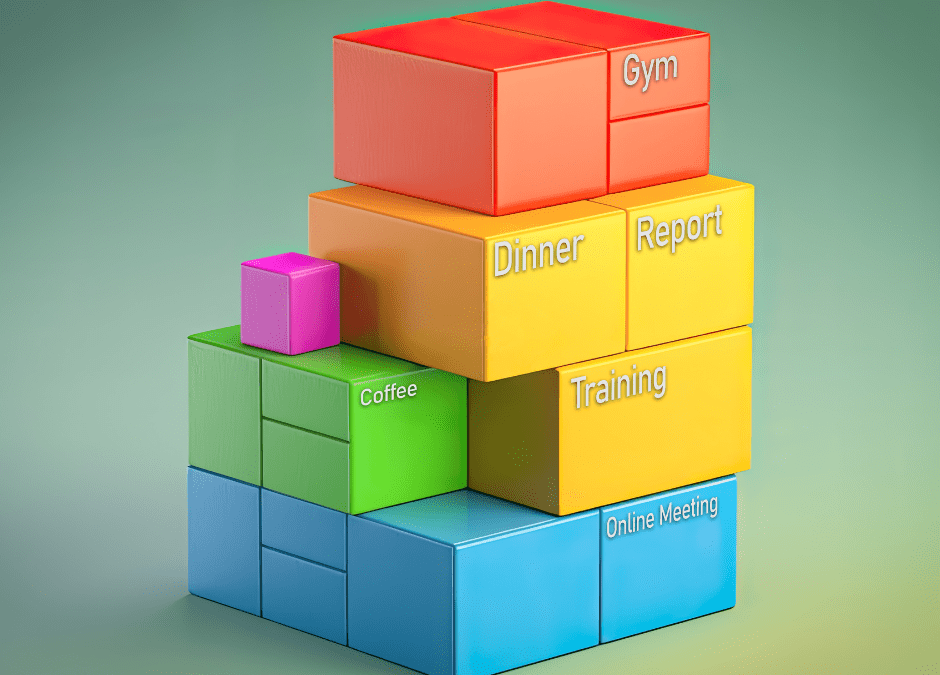
by Lori Vande Krol | Sep 7, 2023 | Goals and Priorities, Habits, Planning, Time Management, Tools
“I’ve tried time blocking in the past and it’s never worked for me.”
This was a recent statement from a client who I was helping with time management. Once we dug in more, we found it wasn’t that time blocking was an ineffective method, but that it wasn’t being applied in the most ideal way for him. This isn’t an uncommon complaint. In fact, even David Allen, productivity guru and author of Getting Things Done, used to argue against time blocking. He preferred a simple calendar with only the necessary appointments and deadlines. But eventually, he realized time blocking can work well for many people and even began practicing it himself.
Let’s dive a little deeper into what time blocking is, who can benefit (*hint* – everyone!), and how it might work best for you. I also share tips, tools, and resources to support your time-blocking habits.
Wikipedia defines Time Blocking as:
“A productivity technique for personal time management where a period of time—typically a day or week—is divided into smaller segments or blocks for specific tasks or to-dos. It integrates the function of a calendar with that of a to-do list. It is a kind of scheduling.”
While I agree with this definition of time blocking, there is much more to it than this.
Who should use a time-blocking technique?
Time blocking is best used for people who:
- Have a busy schedule and need to be very intentional about how they use their time,
- Have a fairly open schedule that can be wasted away if time is not blocked to work on specific tasks and projects (aka Parkinson’s Law),
- Reach the end of a day or week feeling stressed and unaccomplished, wondering where the time went,
- Juggle multiple areas of work and life,
- Struggle to find time for focus and big-picture thinking,
- Deal with constant interruptions, or
- Spend too much time “reacting” to the day’s urgencies.
If we are honest, isn’t this all of us at one point or another? I believe that some form of time blocking can work for almost everyone. The key is finding the method, or combination of methods, that works best for you.
Types of Time Blockers
While there are many different ways to apply time blocking to your calendar, we can simplify it by looking at three key methodologies.
1. The Serious Blocker divides their day into specific blocks of time, each dedicated to accomplishing a specific task, or group of tasks. They start each day, or week, with a concrete schedule that lays out what they will work on and when. A serious blocker will work to bunch related tasks (i.e. “task batching”) such as email processing, social media creation, or phone calls, into one block.
In addition, the serious blocker lumps meetings together. That way, they can spend larger chunks of time on focused projects and tasks versus shorter amounts of time spread between meetings throughout the day. This type of time blocking requires more work upfront, and potential cooperation from others, to reschedule meetings that will better fit your ideal schedule.
2. The Flexible Blocker applies time blocking in a broader way, with more general blocks that are flexible depending on what comes up throughout the day. This works well when your days are less predictable and require a more “reactive” approach (e.g. a customer service specialist). Some argue that these types of schedules aren’t compatible with time blocking, but when your workday is often run by outside forces, it’s easy to lose sight of your own goals. Even a simple version of time blocking can help you gain a greater sense of control over unpredictable schedules. You can still block off time for your “reactive work,” and then be more intentional about time during the day that allows for some planning and control (regardless of how little).
3. The Time Themer chooses themes for work they will do during certain time blocks. This is the most open-ended version of time blocking. “Day theming” is the most popular example where you choose a theme for each day of the week. For example: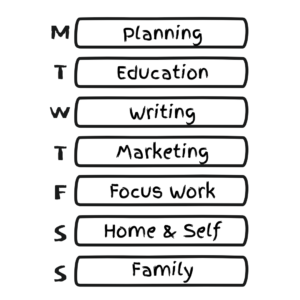
Any open time is spent on that day’s area of focus. Day theming minimizes the choices you need to make about what to work on throughout the day. You look to your theme and choose tasks based on that theme.
You can also use time theming to break up your day by assigning themes to blocks of time throughout the day. An example of this would be: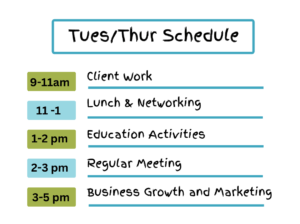 The schedule may be the same every day or may differ throughout the week. In the example above, Tuesday and Thursday have the same “themed schedule” while the other days look different. In the resources section below I share a template called My Productive Week that can be of great assistance in defining your daily “theme blocks.”
The schedule may be the same every day or may differ throughout the week. In the example above, Tuesday and Thursday have the same “themed schedule” while the other days look different. In the resources section below I share a template called My Productive Week that can be of great assistance in defining your daily “theme blocks.”
Most people do not fit perfectly into one time theming option but instead use a combination. For example, having a schedule of daily themes can make it easier to determine what tasks to put into working time blocks when using the “serious” or “flexible” blocking methods.
The Benefits of Time Blocking
While it takes some work, and potentially a change in mindset, the following benefits of time blocking show the value of this time management methodology.
- Your need to make decisions at every point in time throughout the day is minimized because your schedule is pre-defined. This saves time and energy throughout your week.
- If you get easily distracted or off-track, a time-blocked calendar will help to pull you back into focus. In addition, time blocking helps to fight multi-tasking allowing you to focus all of your energy on one thing at a time.
- You will get more realistic about how long things take. We often underestimate the time tasks and activities take, and this is a concrete way to see that. This will get better over time.
- When you see your priorities laid out in your finite calendar, you can more easily say “no” to those things that don’t fit.
- You are more likely to accomplish your goals if you schedule specific, intentional time to work on them.
- It will be easier to relax during your leisure time as you know you have a plan to get everything done.
“A 40 hour time-blocked work week, I estimate, produces the same amount of output as a 60+ hour work week pursued without structure.”
– Cal Newport, Author of Deep Work –
Tips for Effective Time Blocking
Below are key things to consider when working to design and maintain your own time-blocking routine.
- Build your time-blocking methodology into regular weekly planning. Look at your upcoming schedule, deadlines, and tasks and fit it all together to create a week that takes into account your goals, priorities, and commitments.
- Review your schedule daily and reset your week as necessary.
- Your routines and habits should be incorporated into your time blocks.
- Leave a time block for an overflow of tasks that take longer than expected or for unexpected appointments or to-dos that come up during the week.
- Once your week is planned, make intentional choices when straying from that plan.
- Leave space between, or within, blocks for transition, travel, time, and necessary breaks.
- Bunch your urgent but less important work together and dedicate a pre-determined amount of time to it. This allows for longer, uninterrupted time for focused work.
- Consider your daily rhythms in your schedule. When are you most energetic, productive, or focused?
- Evaluate your time-blocking schedule regularly and make needed changes.
- When scheduling time blocks for focused work, find a quiet location free of interruptions and/or block notifications on your computer and phone.
- Consider whether you want to block time on weekends (or other non-working days). You may want to leave these times open to allow freedom and flexibility with leisure time.
Most importantly, remember your time-blocked schedule is a guide to assist you with creating your most productive week. If you try to stick to it perfectly, especially at first, you will get overwhelmed when things come up that cause needed changes to your schedule. Review, reset with intentional decisions, and move forward. You might look at time blocking as a game or a puzzle. How can I fit it all in the most optimal way? But as with any game, you will make mistakes, learn along the way, and get better with practice.
Time Blocking Resources
The following resources can help you create your own time-blocked schedule.
- My Productive Week Template
I have created this tool as a template to build your “puzzle” for your time-blocked weekly calendar. It is to be used as a guide – along with your weekly schedule, goals, and tasks – for your weekly planning. The template can be completed digitally or printed.
- The ProAction Planner:
If you prefer to do your weekly planning with a paper planner, which allows for better mental processing and decision-making, the ProAction Planner is a tool to support all of the important areas of planning and time management. A paper planner provides an easy visual that stays in front of you throughout your day. If using a paper planner, I recommend using a writing instrument that allows for change throughout the week. My tool of choice is the Frixion Clicker Erasable Gel Pen, in multiple colors.
- Online Calendar (Outlook, Google, Other)
Whether or not you use a paper planner for weekly planning, the majority of us use an online calendar to keep track of our meetings and appointments. If you choose to use an online calendar for time-blocking, consider color-coding the blocks of time you wish to be flexible. I like to color my movable time blocks with yellow and mark them as “free.” Also consider those time blocks that you want to protect, mark them as busy, and consider them a meeting with yourself.
- Pomodoro Technique and Tools
The Pomodoro Technique is a method in which you focus for timed periods with short breaks between blocks. Learn more about this technique on their website and search for apps like this one to support the technique.
If you are interested in some assistance in determining and implementing the right time-blocking solution for you, please reach out. I’d love to help.

by Lori Vande Krol | Feb 23, 2023 | General Productivity, Time Management, Tools
Do you like to listen to podcasts or audio books when you travel? Are you an audio learner and would rather listen to a book than read it? I often get requests from clients for recommendations of what to listen to related to productivity and time management. While I have a handful of these I typically recommend, I decided to reach out to my colleagues, fellow Productivity Consultants and Coaches, to see what they enjoy listening to and recommend to others.
The following list, available as a download, provides links to 18 podcasts and 10 audiobook recommendations. All relate to areas of productivity in work and life such as time management, habits, leadership principles, business growth, efficiency, focus, prioritization, and more. Some you may have heard of but I think others will surprise you.
Let us know if we are missing any of your favorites!




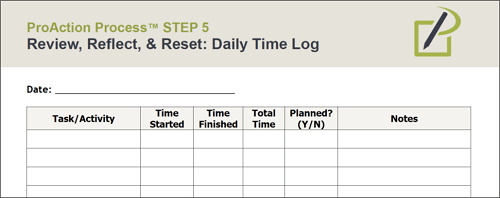



 The schedule may be the same every day or may differ throughout the week. In the example above, Tuesday and Thursday have the same “themed schedule” while the other days look different. In the resources section below I share a template called My Productive Week that can be of great assistance in defining your daily “theme blocks.”
The schedule may be the same every day or may differ throughout the week. In the example above, Tuesday and Thursday have the same “themed schedule” while the other days look different. In the resources section below I share a template called My Productive Week that can be of great assistance in defining your daily “theme blocks.”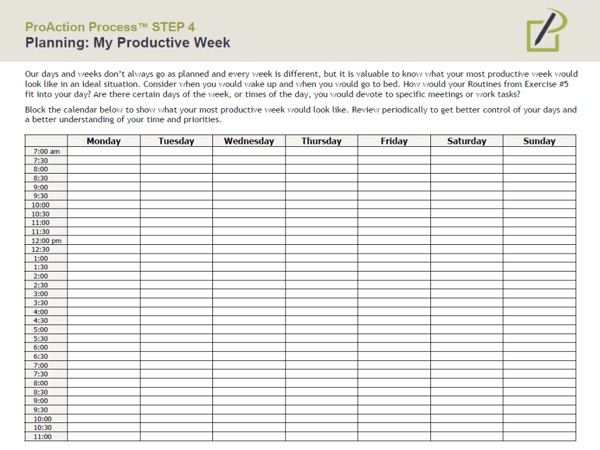

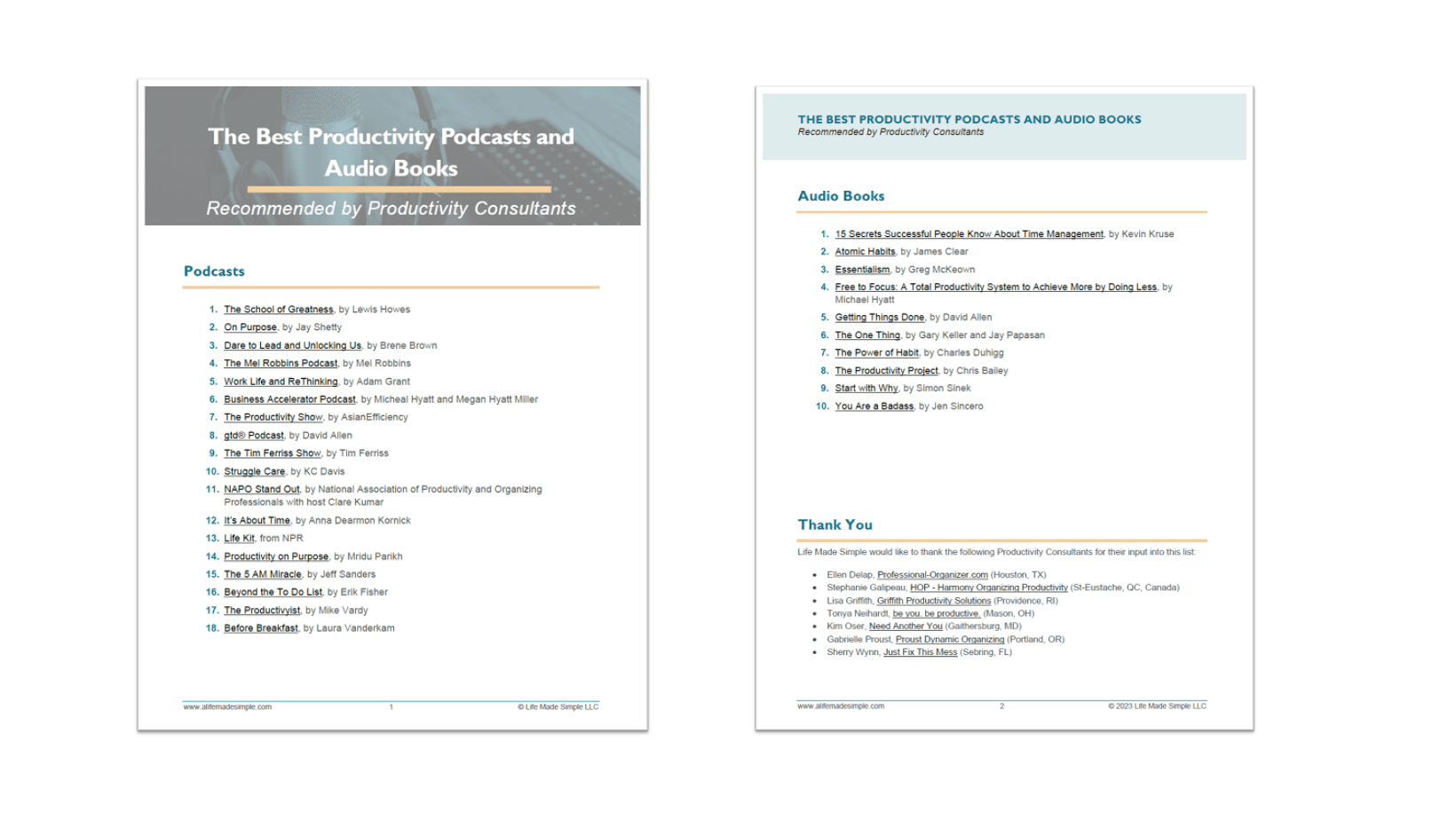
Recent Comments